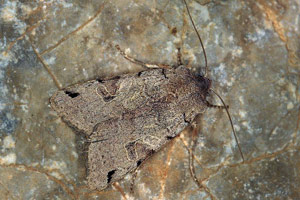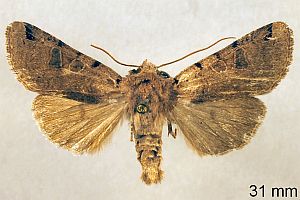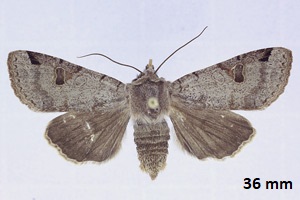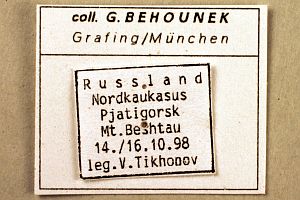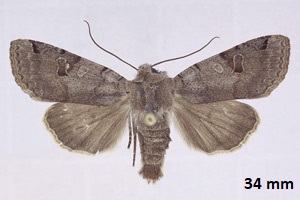1. Lebendfotos
1.1. Falter
2. Diagnose
2.1. Männchen
2.2. Weibchen
2.3. Erstbeschreibung
3. Weitere Informationen
3.1. Andere Kombinationen
- Amathes litura var. luteogrisea Warren, 1911 [Originalkombination]
- Anchoscelis luteogrisea (Warren, 1911) [so bei Beshkov & Nahirnić (2018), Anchoscelis wird ansonsten meist als Untergattung von Agrochola gewertet]
3.2. Faunistik
Die Art wurde aus "Amasia" (Türkei) beschrieben.
Kravchenko et al. (2008: 227) schrieben zur Gesamtverbreitung: "Distribution: West-Palearctic. Morocco, Algeria, Central and Southern Europe, Turkey, Israel and Lebanon. In Israel: widespread in the temperate region. Common at medium altitudes, elsewhere rare and localized."
Der oben gezeigte Beleg aus dem russischen Nordkaukasus gehört je nach Definition zu Europa.
Die ersten klar Europa zuzuordnenden Nachweise dieser Art erfolgten im Jahr 2002 in Nordgriechenland durch Wegner (2011). Nach Fibiger et al. (2010) wurde die anatolisch verbreitete Art jüngst auf Samos nachgewiesen. Diese Funde durch Fritsch et al. (2014) fanden 2009 und 2011 statt.
Im Abstract von Beshkov (2016) ist zu lesen: Agrochola luteogrisea (Warren, 1911) and Dryobotodes servadeii Parenzan, 1982 are reported for a first time for Serbia from the Vranje Region, in the south. Agrochola luteogrisea is also new for Bulgaria from the Kresna Gorge. This is a significant range extension for both species. [...] It is likely that A. luteogrisea has been overlooked in Europe due to confusion with A. litura."
Beshkov & Nahirnić (2018) melden erste Funde aus Mazedonien und Albanien, wo die Art z.T. gemeinsam mit Agrochola litura auftritt, von der sie nur genitaliter sicher zu trennen ist.
Beshkov et al. (2021: 227) berichten über weitere Funde in Nordmazedonien und Südwest-Bulgarien und kommentieren: "Anchoscelis luteogrisea is reported here for the second time from both North Macedonia and Bulgaria. In North Macedonia it was known only from Velestovo near Lake Ohrid and in Bulgaria only from Kresna Gorge (Beshkov 2016; Beshkov and Nahirnić 2018b). Anchoscelis luteogrisea is a late autumn species, only recently identified from Bulgaria, North Macedonia, Serbia and Albania. Because of small differences there is a possibility of misidentification with the closely related species A. litura (Linnaeus, 1758) (Beshkov and Nahirnić 2020)."
(Autor: Erwin Rennwald)
3.3. Literatur
- Beshkov, S. (2016): Agrochola luteogrisea (Warren, 1911) new for Bulgaria and Serbia and Dryobotodes servadeii Parenzan, 1982 (Lepidoptera: Noctuidae) new for Serbia with taxonomic notes on Dryobotodes servadei Dryobotodes monochroma (Esper, [1790]). — The Entomologist's Record and Journal of Variation 128 (5): ...-... [Abstract auf entrecord.com].
- Beshkov, S., Gashtarov, V. & V. Hula (2021): Contribution to knowledge of the Balkan Macroheterocera: new and rare species for Bulgaria, North Macedonia and Albania. — Nota Lepidopterologica, 44: 223–237. DOI 10.3897/nl.44.64804. [zum open-access-Artikel auf pensoft.net]
- Beshkov, S. & A. Nahirnić (2018): Three new Anchoscelis Guenée, 1839 species for Albania and two for the Republic of Macedonia (Lepidoptera, Noctuidae). — Atalanta, 49 (1-4): 171-176.
- Fritsch, D., Stangelmaier, G., Top-Jensen, M., & K. Bech (2014): Die nachtaktive Großschmetterlingsfauna von Samos (Griechenland, Östliche Ägäis) (Lepidoptera: Cossoidea, Lasiocampoidea, Bombycoidea, Drepanoidea, Geometroidea, Noctuoidea). — Esperiana 19: 7-101. Bad Staffelstein.
- Kravchenko, V.D., Fibiger, M., Mooser, J., Junnila, A. & G.C., Müller (2008): The Israeli species of the subtribe Xylenina (Lepidoptera: Noctuidae, Xyleninae). — SHILAP Revista de Lepidopterología, 36 (141): 9-17. [PDF auf redalyc.org]
- Erstbeschreibung: Warren, W. (1909-1913): Noctuidae. — In: Seitz, A. (1909-1914): Die Gross-Schmetterlinge der Erde 3: 9-444 + pl. 2-75. Stuttgart (Alfred Kernen).
- Wegner, H. (2011): Zweiter Beitrag zur Frühjahrs- und Herbst-Noctuidenfauna von Nordgriechenland (Lepidoptera: Noctuidae). — Esperiana. Buchreihe zur Entomologie. Band 16: 39-65. Schwanfeld.




![Vorkommen in Serbien [Jakšić (2021): XXVI Noctuoidea]](/res/img/flag/rs.gif)
![Vorkommen in Nordmazedonien [Beshkov & Nahirnić (2018)]](/res/img/flag/mk.gif)
![Vorkommen in Albanien [Beshkov & Nahirnić (2019)]](/res/img/flag/al.gif)


![Vorkommen im asiatischen Teil der Türkei [Koçak & Kemal (2018)]](/res/img/flag/tr.gif)
![Vorkommen in Iran [Rajaei & al. (2023)]](/res/img/flag/ir.gif)

![Vorkommen in Israel [Kravchenko, Fibiger, Mooser, Junnila & Müller (2008)]](/res/img/flag/il.gif)



